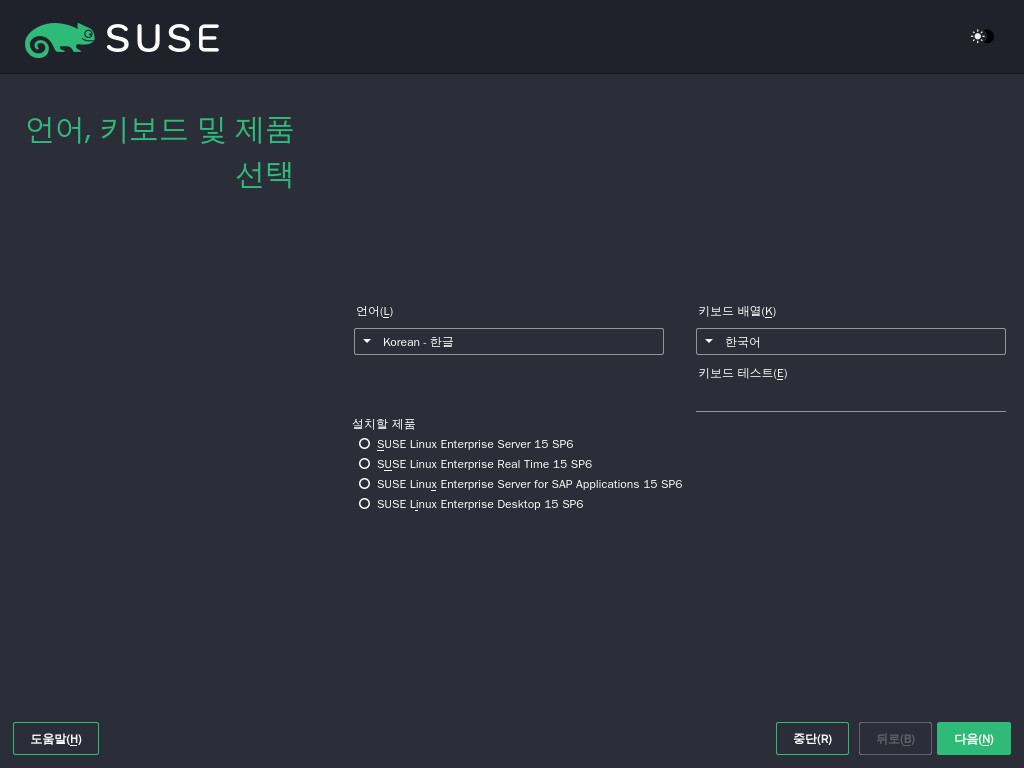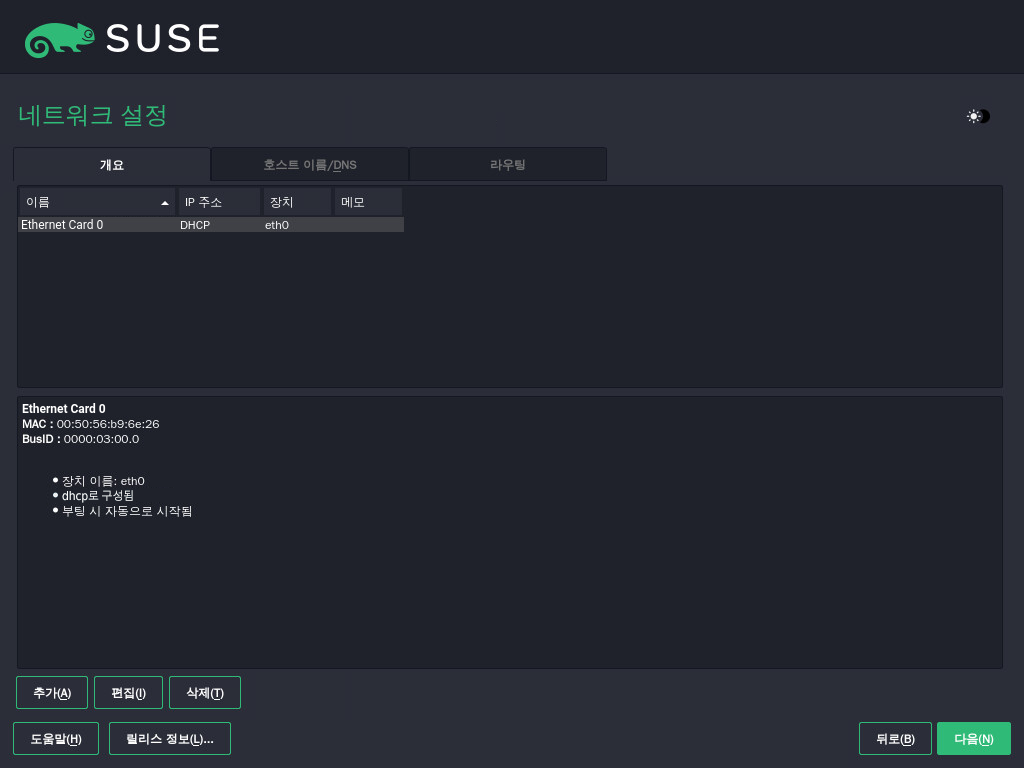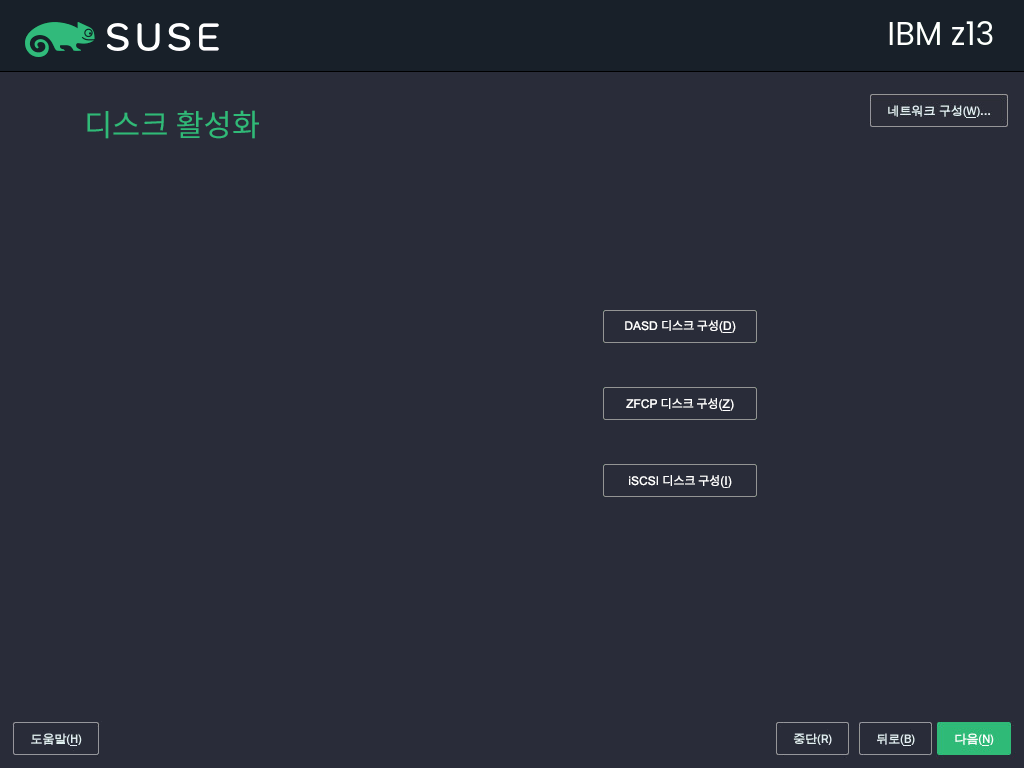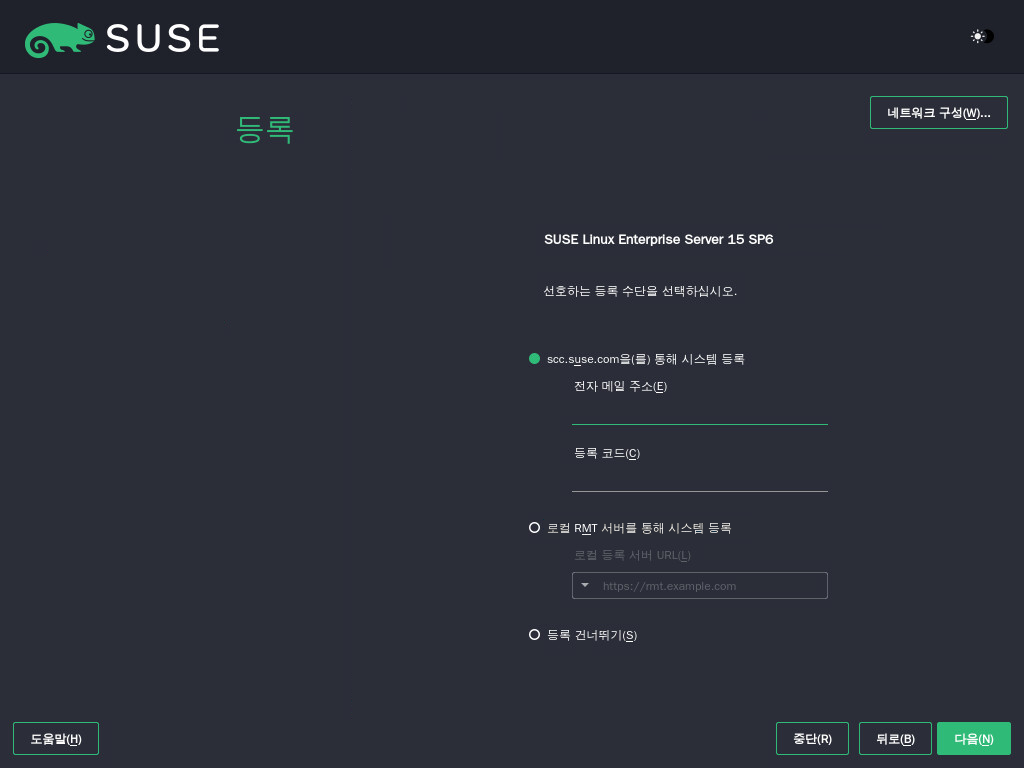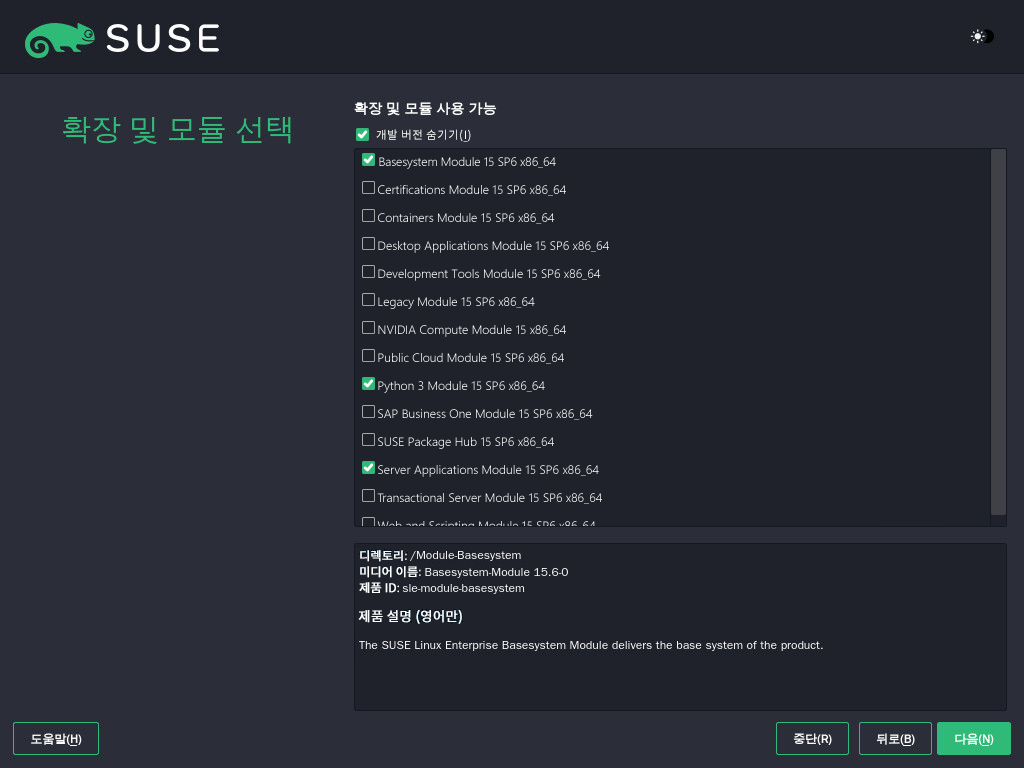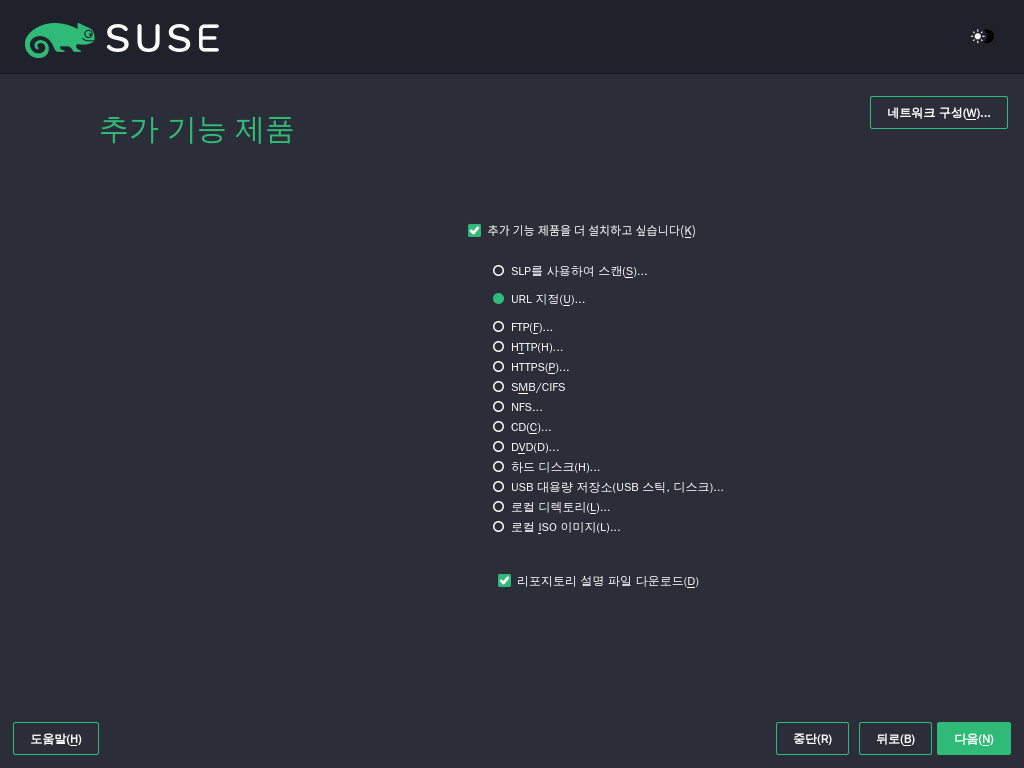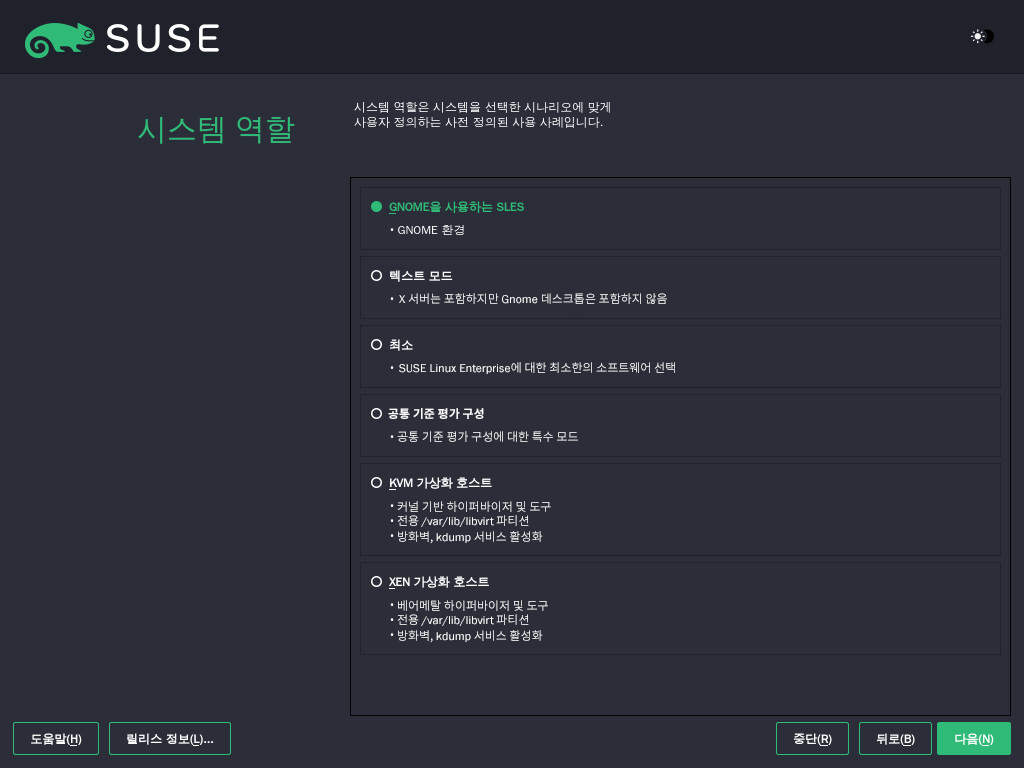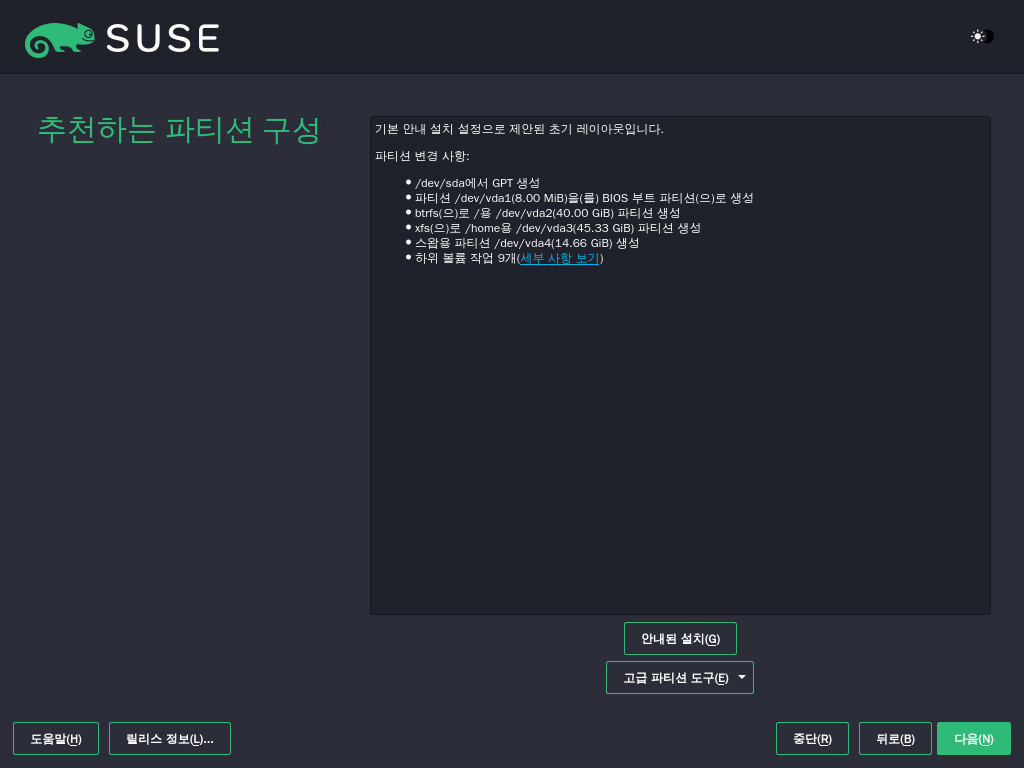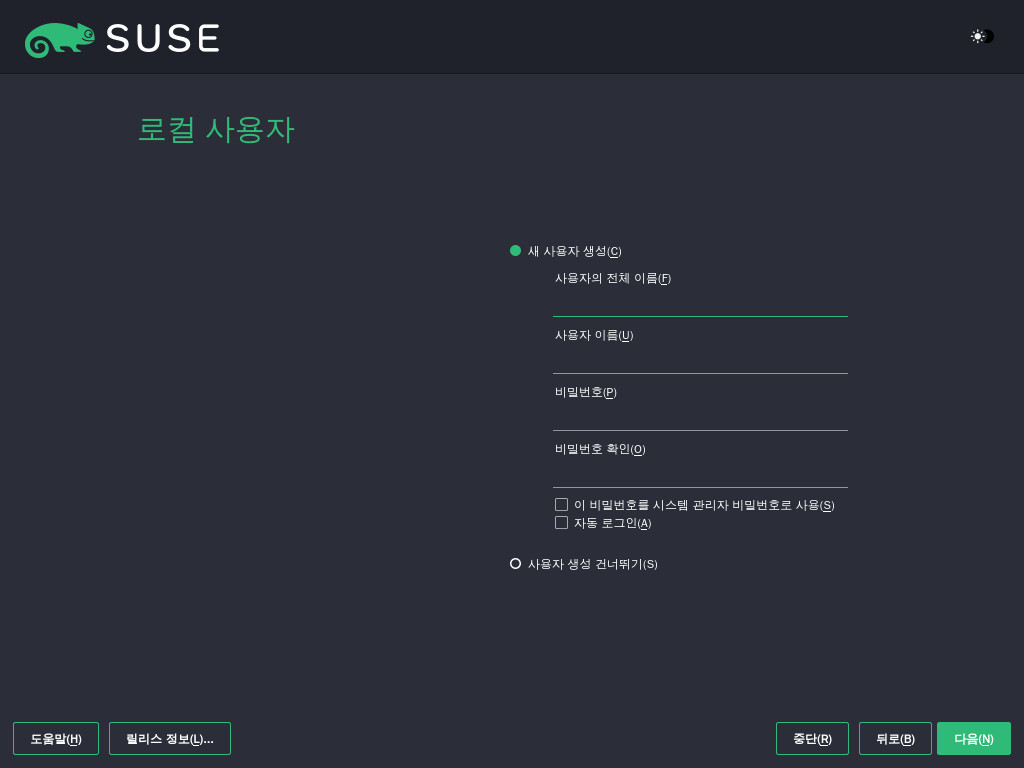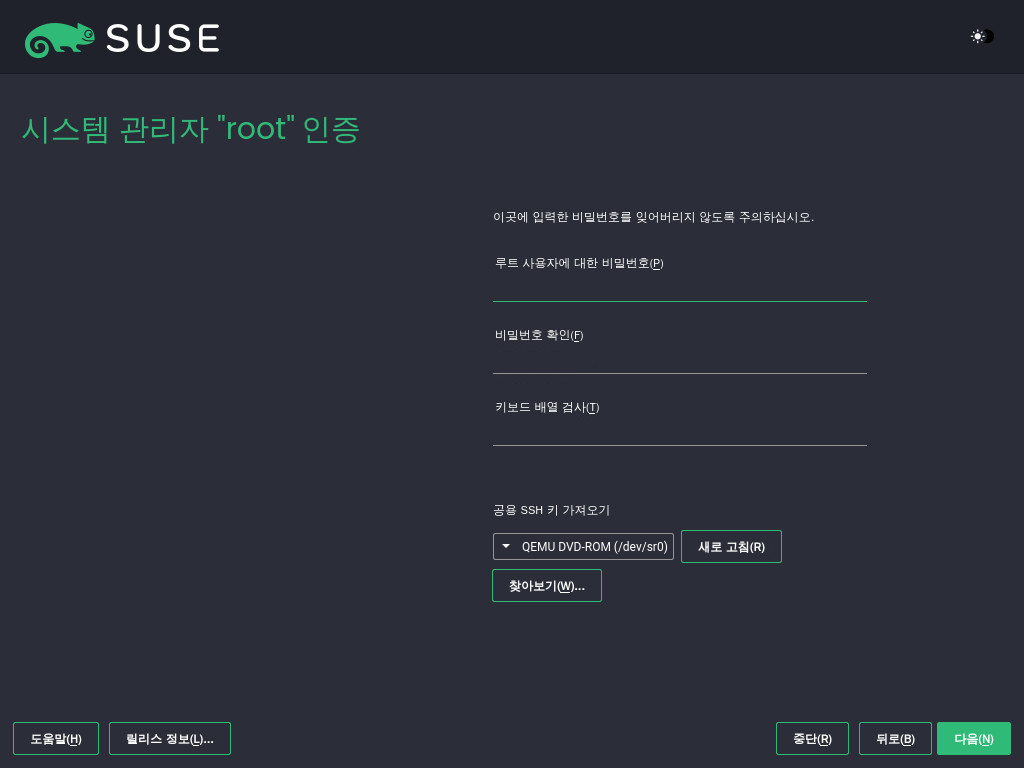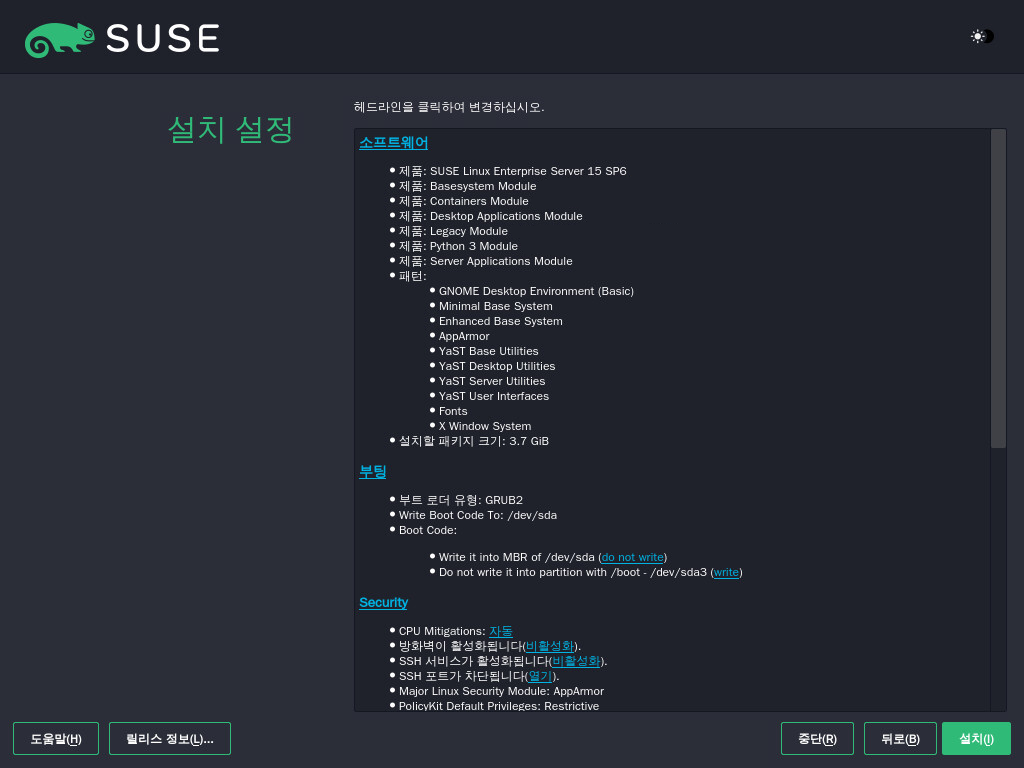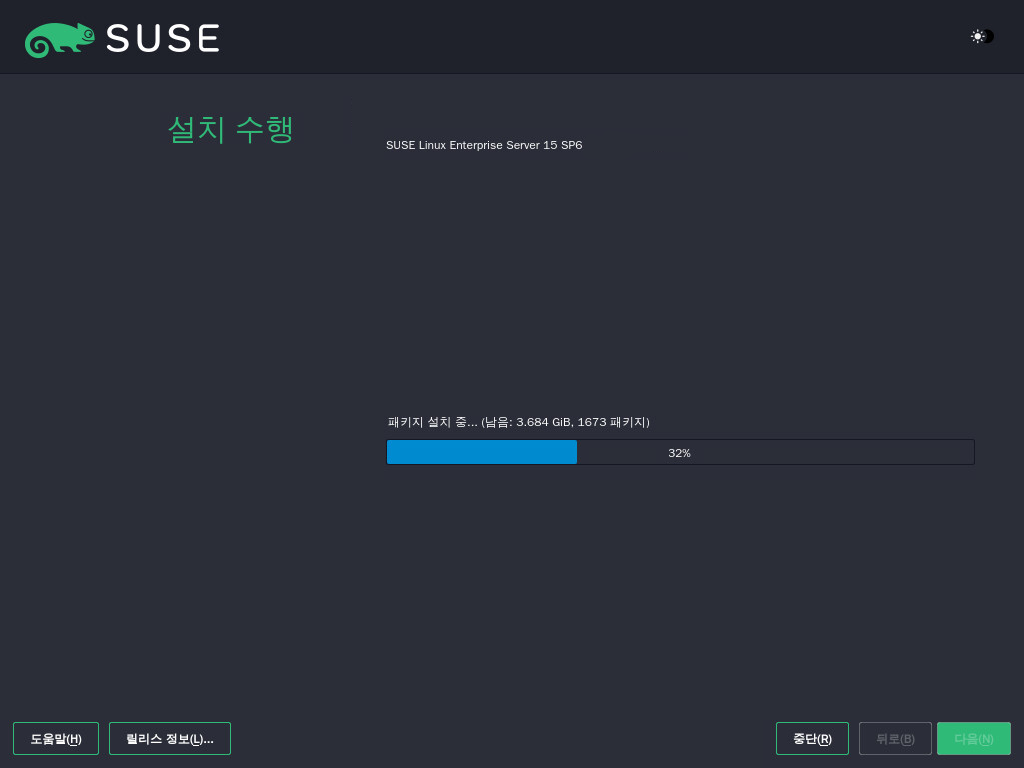설치 빠른 시작 #
이 빠른 시작은 SUSE® Linux Enterprise Server 15 SP6를 단계별로 설치하도록 안내합니다.
1 SUSE Linux Enterprise Server 시작 #
지원되는 모든 하드웨어 플랫폼에 제품을 설치하려면 다음 절차를 사용하십시오. /IPLed를 설치 시스템으로 부팅한다고 가정합니다. 더욱 자세한 설치 지침 및 배포 전략은 Book “배포 가이드” 항목을 참조하십시오. 설치 시스템으로 부팅하거나 IPL을 수행하는 데 필요한 플랫폼별 준비는 앞서 언급한 안내서의 다음 부분을 참조하십시오.
Book “배포 가이드”, Chapter 2 “AMD64 및 Intel 64에 설치”
Book “배포 가이드”, Chapter 3 “Arm AArch64에 설치”
Book “배포 가이드”, Chapter 4 “IBM POWER에 설치”
Book “배포 가이드”, Chapter 5 “IBM Z 및 LinuxONE에 설치”
1.1 통합 설치 프로그램 #
SUSE Linux Enterprise Server 15부터 설치 미디어는 모든 SUSE Linux Enterprise 기반 제품을 설치, 업데이트 및 등록하기 위한 MSYS인 통합 설치 프로그램으로만 구성됩니다. 설치 중에 통합 설치 프로그램 상단에 설치할 모듈 및 확장을 선택하여 기능을 추가할 수 있습니다.
1.2 오프라인으로 또는 등록 없이 설치 #
기본 설치 매체인 SLE-15-SP6-Online-ARCH-GM-media1.iso는 크기에 최적화되었으며 모듈과 확장 프로그램을 포함하지 않습니다. 그러므로 설치하려면 네트워크에 액세스하여 제품을 등록하고 리포지토리 데이터에서 모듈 및 확장 프로그램을 검색해야 합니다.
시스템을 등록하지 않고 설치하려면 https://www.suse.com/download/sles/의 SLE-15-SP6-Full-ARCH-GM-media1.iso 이미지를 사용하고 자세한 내용은 Book “배포 가이드”, Chapter 9 “설치 단계”, Section 9.7.3 “등록 없이 설치” 항목을 참조하십시오.
다음 명령을 사용하여 설치 이미지의 컨텐트를 이동식 플래시 디스크로 복사합니다.
>sudodd if=IMAGE of=FLASH_DISK bs=4M && sync
IMAGE를 SLE-15-SP6-Online-ARCH-GM-media1.iso의 경로 또는 SLE-15-SP6-Full-ARCH-GM-media1.iso 이미지 파일로 바꿔야 합니다. FLASH_DISK를 플래시 장치로 바꿔야 합니다. 장치를 식별하기 위해 삽입한 후 실행합니다.
# grep -Ff <(hwinfo --disk --short) <(hwinfo --usb --short)
disk:
/dev/sdc General USB Flash Disk장치의 크기가 원하는 이미지에 충분한지 확인합니다. 장치 크기는 다음을 통해 확인할 수 있습니다.
# fdisk -l /dev/sdc | grep -e "^/dev"
/dev/sdc1 * 2048 31490047 31488000 15G 83 Linux
이 예에서 장치의 용량은 15GB입니다. SLE-15-SP6-Full-ARCH-GM-media1.iso에서 사용할 명령은 다음과 같습니다.
dd if=SLE-15-SP6-Full-ARCH-GM-media1.iso of=/dev/sdc bs=4M && sync
dd 명령을 실행하는 경우에는 장치를 장착하지 않아야 합니다. 파티션에 있는 모든 데이터가 삭제됨을 주의하십시오!
2 설치 절차 #
SUSE Linux Enterprise Server를 설치하려면 설치 프로그램 미디어에서 통합 설치 프로그램으로 부팅하거나 IPL을 수행하고 설치를 시작합니다.
2.1 언어, 키보드 및 제품 선택 #
및 설정이 부팅 화면에서 선택한 언어로 초기화됩니다. 기본값을 변경하지 않은 경우에는 영어(미국)로 설정됩니다. 필요한 경우 여기에서 설정을 변경하십시오. 텍스트 상자를 사용하여 레이아웃을 테스트하십시오.
통합 설치 프로그램을 사용하면 다음과 같은 모든 SUSE Linux Enterprise 기반 제품을 설치할 수 있습니다.
SUSE Linux Enterprise Server 15 SP6(여기에 포함됨)
SUSE Linux Enterprise Desktop 15 SP6(설치 지침은 https://documentation.suse.com/sled/ 참조)
SUSE Linux Enterprise Real Time 15 SP6(설치 지침은 https://documentation.suse.com/sle-rt/ 참조)
SUSE Linux Enterprise Server for SAP Applications 15 SP6(설치 지침은 https://documentation.suse.com/sles-sap 참조)
SUSE Manager Server 5.0(설치 지침은 https://documentation.suse.com/suma/ 참조)
SUSE Manager Proxy 5.0(설치 지침은 https://documentation.suse.com/suma/ 참조)
SUSE Manager Retail Branch Server 5.0(설치 지침은 https://documentation.suse.com/suma-retail 참조)
설치할 제품을 선택합니다. 각 제품에 대한 등록 코드가 있어야 합니다. 이 문서에서는 SUSE Linux Enterprise Server를 선택한 것으로 가정합니다. 을 눌러 계속합니다.
2.2 사용권 계약 #
사용권 계약을 읽어보십시오. 사용권 계약은 부팅 화면에서 선택한 언어로 표시됩니다. 번역은 드롭다운 상자를 통해 이용할 수 있습니다. 를 설치하려면 동의함을 선택하여 계약에 동의해야 합니다. 을 눌러 계속합니다.
2.3 네트워크 설정 #
시스템 분석을 수행하고, 설치 프로그램이 저장 장치를 검사하고 다른 설치된 시스템을 찾습니다. 설치를 시작하는 중에 네트워크가 DHCP를 통해 자동으로 구성된 경우 등록 단계로 이동합니다.
네트워크가 아직 구성되지 않은 경우 대화 상자가 열립니다. 목록에서 네트워크 인터페이스를 선택하고 으로 구성합니다. 또는 인터페이스를 직접 합니다. 자세한 내용은 Book “배포 가이드”, Chapter 9 “설치 단계”, Section 9.6 “네트워크 설정” 및 Book “Administration Guide”, Chapter 23 “Basic networking”, Section 23.4 “Configuring a network connection with YaST” 항목을 참조하십시오. 네트워크 액세스 없이 설치를 수행하려는 경우 변경 사항 없이 이 단계를 건너뛰어 으로 계속 진행합니다.
2.4 IBM Z: 디스크 활성화 #
IBM Z 하드웨어에 설치하지 않는 경우 이 단계를 건너뛰십시오.
부착된 하드 디스크를 구성합니다. SUSE Linux Enterprise Server 설치를 위해 DASD, zFCP(Fibre Channel Attached SCSI Disks) 또는 iSCSI를 선택합니다. 해당하는 장치가 연결된 경우에만 DASD 및 zFCP 구성 버튼을 사용할 수 있습니다. 을 눌러 계속 진행하여 선택한 디스크 유형을 설정합니다. 자세한 내용은 Book “배포 가이드”, Chapter 9 “설치 단계”, Section 9.5 “IBM Z: 디스크 활성화”를 참조하십시오.
2.5 등록 #
기술 지원과 제품 업데이트를 받으려면 SUSE Customer Center 또는 로컬 등록 서버에서 SUSE Linux Enterprise Server를 등록하고 활성화해야 합니다. 이 단계에서 제품을 등록하면 업데이트 리포지토리에 대한 즉각적인 액세스 권한도 부여됩니다. 그러면 제공되는 최신 업데이트와 패치를 사용하여 시스템을 설치할 수 있습니다.
등록할 때, 모듈 및 확장에 대한 리포지토리와 종속성이 등록 서버에서 로드됩니다.
SUSE Customer Center로 등록하려면 SUSE Customer Center 계정과 연결된 및 의 등록 코드를 입력합니다. 을 눌러 계속합니다.
조직에서 로컬 등록 서버를 제공하는 경우 대안으로 로컬 등록 서버에서 등록할 수 있습니다. 을 활성화하고 드롭다운 상자에서 URL을 선택하거나 주소를 입력합니다. 을 눌러 계속합니다.
오프라인 상태이거나 등록을 건너뛰려면 를 활성화합니다. 으로 경고를 승인하고 으로 계속 진행합니다.
중요: 등록 건너뛰기업데이트를 검색하고 지원을 받으려면 시스템 및 확장을 등록해야 합니다. 등록을 건너뛰는 것은
SLE-15-SP6-Full-ARCH-GM-media1.iso이미지에서 설치하는 경우에만 가능합니다.설치 중에 등록하지 않은 경우 나중에 실행하는 시스템에서 언제든지 수행할 수 있습니다. 등록을 건너뛰려면 › 또는 명령줄 도구
SUSEConnect를 실행합니다.
SUSE Linux Enterprise Server를 성공적으로 등록하면 설치 중에 사용 가능한 최신 온라인 업데이트를 설치할지 여부를 묻는 메시지가 표시됩니다. 를 선택하면 시스템에 최신 패키지가 설치되므로 설치 후에 업데이트를 적용할 필요가 없습니다. 이 옵션을 활성화하는 것이 좋습니다.
기본적으로 SUSE Linux Enterprise Server의 방화벽은 수신 연결만 차단합니다. 시스템이 발신 트래픽을 차단하는 다른 방화벽 뒤에 있는 경우 업데이트를 받기 위해 포트 80 및 43에서 https://scc.suse.com/ 및 https://updates.suse.com으로의 연결을 허용해야 합니다.
2.6 확장 및 모듈 선택 #
시스템을 등록하면 설치 프로그램에서 SUSE Linux Enterprise Server에 사용할 수 있는 모듈 및 확장을 나열합니다. 모듈은 요구 사항에 따라 제품을 사용자 정의할 수 있도록 하는 구성 요소입니다. SUSE Linux Enterprise Server 구독에 포함되어 있습니다. 확장은 제품에 기능을 추가합니다. 별도로 구매해야 합니다.
특정 모듈 또는 확장의 가용성은 이 설치의 첫 번째 단계에서 선택한 제품에 따라 다릅니다. 모듈 및 라이프사이클에 대한 설명은 모듈을 선택하여 함께 제공된 텍스트를 참조하십시오. 자세한 내용은 Modules and Extensions Quick Start에서 확인할 수 있습니다 .
모듈 선택은 설치 및 실행 중인 시스템에 사용할 수 있는 소프트웨어 소스(리포지토리)를 정의하므로 설치 범위에 간접적으로 영향을 줍니다.
다음 모듈 및 확장은 SUSE Linux Enterprise Server에 사용할 수 있습니다.
- Basesystem 모듈
이 모듈은 통합 설치 프로그램 상단에 기본 시스템을 추가합니다. 다른 모든 모듈 및 확장에서 필요합니다. 기본 시스템만 포함하는 설치 범위는 이전 SUSE Linux Enterprise Server 버전의 설치 패턴인 minimal system과 비슷합니다. 이 모듈은 설치를 위해 기본적으로 선택되며, 선택 취소할 수 없습니다.
종속성: 없음
- 인증 모듈
FIPS 인증 패키지를 포함합니다.
종속성: Basesystem
- Containers 모듈
컨테이너에 대한 지원 및 도구를 포함합니다.
종속성: Basesystem
- Desktop Applications 모듈
그래픽 사용자 인터페이스 및 핵심 데스크톱 응용 프로그램을 시스템에 추가합니다.
종속성: Basesystem
- Development Tools 모듈
응용 프로그램을 컴파일하고 디버깅하는 데 필요한 컴파일러(gcc 포함) 및 라이브러리를 포함합니다. 이전 SDK(Software Development Kit: 소프트웨어 개발 키트)를 교체합니다.
종속성: Basesystem, Desktop Applications
- 고성능 컴퓨팅(HPC) 모듈
수치 집약적인 고성능 워크로드에 일반적으로 사용되는 특정 도구를 제공합니다.
종속성: Basesystem
- Legacy 모듈
SUSE Linux Enterprise에서 중단되는 패키지를 제공하여 응용 프로그램을 SUSE Linux Enterprise Server 이전 버전 및 기타 시스템에서 SLES 15 SP6로 마이그레이션할 수 있도록 지원합니다. 이 모듈의 패키지는 마이그레이션에 대한 요구사항과 구성의 복잡성 수준에 따라 선택됩니다.
이 모듈은 이전 제품 버전에서 마이그레이션하는 경우 권장됩니다.
종속성: Basesystem, Server Applications
- NVIDIA Compute 모듈
NVIDIA CUDA(Compute Unified Device Architecture) 드라이버를 포함합니다.
이 모듈의 소프트웨어는 CUDA End User License Agreement에 따라 NVIDIA가 제공하며 SUSE에서 지원하지 않습니다.
종속성: Basesystem
- Public Cloud Module
AWS(Amazon Web Services), Microsoft Azure, Google Compute Platform 또는 OpenStack 등의 클라우드 환경에서 SUSE Linux Enterprise Server를 배포하기 위한 이미지를 생성하는 데 필요한 모든 도구를 포함합니다.
종속성: Basesystem, Server Applications
- Python 3 모듈
이 모듈은 선택한 Python 3 패키지의 최신 버전을 포함합니다.
종속성: Basesystem
- SAP Business One Server
이 모듈에는 SAP Business One Server에 특화된 패키지 및 시스템 구성이 포함되어 있습니다. 이 모듈은 SUSE Linux Enterprise Server 제품 구독을 통해 유지 관리 및 지원됩니다.
종속성: Basesystem, Server Applications, Desktop Applications, Development Tools
- Server Applications 모듈
DHCP 서버, 이름 서버 또는 웹 서버 등의 네트워크 서비스를 제공하여 서버 기능을 추가합니다. 이 모듈은 설치 대상으로 기본적으로 선택되며, 선택을 취소하지 않는 것이 좋습니다.
종속성: Basesystem
- SUSE Linux Enterprise High Availability
중요 업무용 설정에 대한 클러스터링 지원을 SUSE Linux Enterprise Server에 추가합니다. 이 확장에는 별도의 사용권 키가 필요합니다.
종속성: Basesystem, Server Applications
- SUSE Linux Enterprise Live Patching
시스템을 종료하지 않고 중요한 패칭 수행에 대한 지원을 추가합니다. 이 확장에는 별도의 사용권 키가 필요합니다.
종속성: Basesystem, Server Applications
- SUSE Linux Enterprise Workstation Extension
추가 데스크톱 응용 프로그램(Office 제품군, 전자 메일 클라이언트, 그래픽 편집기 등) 및 라이브러리와 같이 SUSE Linux Enterprise Desktop에서 패키지로 SUSE Linux Enterprise Server의 기능을 확장합니다. 이를 통해 두 제품을 결합하여 전체 기능이 탑재된 워크스테이션을 생성할 수 있습니다. 이 확장에는 별도의 사용권 키가 필요합니다.
종속성: Basesystem, Desktop Applications
- SUSE Package Hub
openSUSE 커뮤니티에서 유지하는 SUSE Linux Enterprise Server의 패키지에 대한 액세스를 제공합니다. 이러한 패키지는 L3 지원 없이 제공되며 SUSE Linux Enterprise Server의 지원 가능성을 방해하지 않습니다. 자세한 내용은 https://packagehub.suse.com/을 참조하십시오.
종속성: Basesystem
- Transactional Server 모듈
트랜잭션 업데이트 지원을 추가합니다. 업데이트는 시스템에 모두 함께 단일 트랜잭션으로 적용되거나 적용되지 않습니다. 실행 중인 시스템에는 영향을 주지 않고 수행됩니다. 업데이트가 실패한 경우 또는 성공적인 업데이트가 호환되지 않거나 업데이트가 잘못된 것으로 간주되는 경우 업데이트를 폐기하여 시스템을 즉시 이전 작동 상태로 되돌릴 수 있습니다.
종속성: Basesystem
- Web and Scripting 모듈
실행 중인 웹 서버용 패키지를 포함합니다.
종속성: Basesystem, Server Applications
일부 모듈은 다른 모듈 설치에 따라 달라집니다. 따라서 모듈을 선택할 때 종속성을 이행하도록 다른 모듈이 자동으로 선택될 수 있습니다.
제품에 따라 등록 서버는 모듈 및 확장을 권장으로 표시할 수 있습니다. 권장된 모듈 및 확장은 등록 및 설치에 대해 미리 선택됩니다. 이러한 권장 사항 설치를 피하려면 직접 선택 취소합니다.
설치할 모듈과 확장을 선택하고 으로 계속 진행합니다. 하나 이상의 확장을 선택한 경우 각각의 등록 코드를 입력하라는 메시지가 표시됩니다. 선택 사항에 따라 추가 사용권 계약을 승인해야 할 수도 있습니다.
SLE-15-SP6-Full-ARCH-GM-media1.iso에서 오프라인 설치를 수행할 때는 기본적으로 만 선택됩니다. SUSE Linux Enterprise Server 기본 패키지 세트 전체를 설치하려면 을 추가 선택하십시오.
2.7 추가 기능 제품 #
대화 상자를 사용하면 SUSE Customer Center에서 제공하지 않는 추가 소프트웨어 소스(“리포지토리”)를 SUSE Linux Enterprise Server에 추가할 수 있습니다. 추가 기능 제품에는 해당 시스템을 위한 타사 제품 및 드라이버와 추가 소프트웨어가 포함될 수 있습니다.
대화 상자를 통해 드라이버 업데이트 리포지토리를 추가할 수도 있습니다. SUSE Linux Enterprise용 드라이버 업데이트가 https://drivers.suse.com/에서 제공됩니다. 이러한 드라이버는 SUSE SolidDriver 프로그램을 통해 생성되었습니다.
이 단계를 건너뛰려면 을 눌러 계속합니다. 그렇지 않은 경우 를 활성화하십시오. 리포지토리를 호스팅하는 미디어 유형, 로컬 경로 또는 네트워크 리소스를 지정하고 온스크린 지침을 따르십시오.
이제 를 선택하여 리포지토리를 설명하는 파일을 다운로드합니다. 비활성화한 경우 설치가 시작된 이후에 파일이 다운로드됩니다. 을 눌러 계속하고 필요에 따라 미디어를 삽입합니다. 제품의 컨텐트에 따라 추가 라이선스 계약에 동의해야 할 수 있습니다. 을 눌러 계속합니다. 등록 키가 필요한 추가 기능 제품을 선택한 경우 다음 단계로 계속 진행하기 전에 이를 입력하라는 메시지가 표시됩니다.
2.8 시스템 역할 #
시스템 역할의 가용성은 모듈 및 확장 선택에 따라 달라집니다. 시스템 역할은 예를 들어 설치에 대해 미리 선택할 소프트웨어 패턴 집합을 정의합니다. 화면에 있는 설명을 참조하여 선택하십시오. 역할을 선택하고 으로 계속 진행합니다. 활성화된 모듈에서 각 기본 제품에 적합한 역할이 단 1개이거나 없는 경우, 대화 상자가 생략됩니다.
이 시점부터 설치 프로세스 중에 원하는 화면에서 를 선택하여 릴리스 정보를 볼 수 있습니다.
2.9 제안된 파티셔닝 #
시스템에 제안된 파티션 설정을 검토합니다. 필요한 경우 제안된 파티션 설정을 변경합니다. 다음과 같은 옵션이 있습니다.
파티셔닝 제안을 상세 검색할 수 있는 마법사를 시작합니다. 여기에서 사용할 수 있는 옵션은 시스템 설정에 따라 달라집니다. 하드 디스크가 두 개 이상인 경우 사용할 디스크와 루트 파티션을 배치할 위치를 선택할 수 있습니다. 디스크에 이미 파티션이 설정되어 있는 경우 제거할지 또는 크기를 조정할지 여부를 결정합니다.
다음 단계에서는 LVM 지원 및 디스크 암호화를 추가할 수도 있습니다. 루트 파티션에 대한 파일 시스템을 변경하고 별도의 홈 파티션을 보유할지 여부를 결정할 수 있습니다.
Book “배포 가이드”, Chapter 11 “”, Section 11.1 “ 사용”에 설명된 를 엽니다. 이를 통해 파티셔닝 설정에 대한 전체 제어 권한이 주어지며 사용자 정의 설정을 생성할 수 있습니다. 이 옵션은 고급용입니다.
파티셔닝 목적을 위해 디스크 공간은 십진법 단위가 아닌 이진법 단위로 측정된다는 점에 유의하십시오. 예를 들어, 크기를 1GiB, 1GB 또는 1G로 입력하는 경우, 이는 1GB(기가바이트)가 아닌 1GiB(기비바이트)를 나타냅니다.
- 이진법
1GiB = 1,073,741,824바이트
- 십진법
1GB = 1,000,000,000바이트
- 차이
1GiB ≈ 1.07GB.
제안된 설정을 변경하지 않고 승인하려면 을 선택하여 계속합니다.
2.10 시계 및 시간대 #
시스템에서 사용할 시간 및 시간대를 선택합니다. 시간을 수동으로 조정하거나 시간 동기화를 위해 NTP 서버를 구성하려면 을 선택합니다. 자세한 내용은 Book “배포 가이드”, Chapter 9 “설치 단계”, Section 9.12 “시계 및 시간대”를 참조하십시오. 을 눌러 계속합니다.
2.11 로컬 사용자 #
로컬 사용자를 생성하려면 필드에 성과 이름을 입력하고, 필드에 로그인 이름을 입력하고, 필드에 비밀번호를 입력합니다.
비밀번호는 8자 이상이어야 하며 대소문자와 숫자를 모두 포함해야 합니다. 비밀번호의 최대 길이는 72자이고 대소문자를 구분합니다.
보안상의 이유로 을 비활성화하는 것이 좋습니다. 또한 이 비밀번호를 시스템 관리자용으로 사용하지 다음 설치 단계에서 별도의 root 비밀번호를 제공해야 합니다.
이전 Linux 설치가 발견된 시스템에 설치하는 경우 할 수 있습니다. 사용 가능한 사용자 계정 목록에 대해 을 클릭합니다. 한 명 이상의 사용자를 선택합니다.
사용자를 중앙에서 관리하는 환경(예: NIS 또는 LDAP)에서는 로컬 사용자 생성을 건너뛸 수 있습니다. 이 경우 를 선택합니다.
을 눌러 계속합니다.
2.12 시스템 관리자 “root”에 대한 인증 #
시스템 관리자(root 사용자라도고 함)의 비밀번호를 입력하거나 공용 SSH 키를 제공합니다. 원하는 경우 둘 다 사용할 수 있습니다.
root 사용자는 광범위한 권한을 갖고 있으므로 신중하게 비밀번호를 선택해야 합니다. root 비밀번호를 반드시 기억해야 합니다. 입력한 후에는 비밀번호를 확인할 수 없습니다.
US ASCII 문자만 사용하는 것이 좋습니다. 시스템 오류가 발생하거나 복구 모드에서 시스템을 시작해야 할 경우 영어 이외의 키보드는 사용하지 못할 수 있습니다.
공용 키를 사용하여 SSH를 통해 원격으로 시스템에 액세스하려면 이동식 미디어 또는 기존 파티션에서 키를 가져오십시오. 자세한 내용은 Book “배포 가이드”, Chapter 9 “설치 단계”, Section 9.14 “시스템 관리자 root에 대한 인증”에서 확인하십시오.
을 눌러 계속합니다.
2.13 설치 설정 #
화면을 사용하여 몇 가지 제안된 설치 설정을 검토하고 필요한 경우 변경합니다. 각 설정에 대한 현재 구성이 나열됩니다. 구성을 변경하려면 헤드라인을 클릭합니다. 방화벽 또는 SSH 등과 같은 일부 설정은 해당 링크를 클릭하여 직접 변경할 수 있습니다.
여기에서 수행 가능한 변경은 설치된 시스템에서도 나중에 언제든지 수행할 수 있습니다. 하지만 설치 바로 후에 원격 액세스가 필요한 경우 설정에서 SSH 포트를 열어야 할 수 있습니다.
설치 범위는 이 설치에 대해 선택한 모듈 및 확장으로 정의됩니다. 그러나 선택 항목에 따라 모듈에서 사용할 수 있는 모든 패키지가 설치에 선택되지는 않습니다.
를 클릭하면 화면이 열립니다. 이 화면에서 패턴을 선택하거나 선택 취소하여 소프트웨어 선택을 변경할 수 있습니다. 각 패턴에는 특정 기능에 필요한 여러 소프트웨어 패키지가 포함되어 있습니다(예: ). 설치할 소프트웨어 패키지를 기반으로 한 상세 선택에 대해서는 을 선택하여 YaST 로 전환하십시오. 자세한 내용은 Book “Administration Guide”, Chapter 8 “Installing or removing software”에서 확인하십시오.
이 섹션에는 부트 로더 구성이 표시됩니다. 정말 필요한 경우에만 기본값을 변경하는 것이 좋습니다. 자세한 내용은 Book “Administration Guide”, Chapter 18 “The boot loader GRUB 2”를 참조하십시오.
는 CPU 부채널 공격을 막기 위해 배포된 소프트웨어 완화를 위한 커널 부팅 명령줄 파라미터를 참조합니다. 선택한 항목을 클릭하여 다른 옵션을 선택합니다. 자세한 내용은 Book “Administration Guide”, Chapter 18 “The boot loader GRUB 2” CPU Mitigations를 참조하십시오.
기본적으로 은 모든 구성된 네트워크 인터페이스에서 활성화됩니다.
firewalld의 완전한 비활성화를 위해 를 클릭합니다(권장되지 않음). 구성에 대한 자세한 내용은 Book “Security and Hardening Guide”, Chapter 23 “Masquerading and firewalls”를 참조하십시오.참고: 업데이트를 받기 위한 방화벽 설정기본적으로 SUSE Linux Enterprise Server의 방화벽은 수신 연결만 차단합니다. 시스템이 발신 트래픽을 차단하는 다른 방화벽 뒤에 있는 경우 업데이트를 받기 위해 포트 80 및 43에서
https://scc.suse.com/및https://updates.suse.com으로의 연결을 허용해야 합니다.가 기본적으로 활성화되어 있지만 방화벽에서 포트 (22)는 닫혀 있습니다. 를 클릭하여 포트를 열거나 를 클릭하여 서비스를 비활성화하십시오. SSH가 비활성화되어 있으면 원격 로그인이 불가능하다는 점에 유의하십시오. 자세한 내용은 Book “Security and Hardening Guide”, Chapter 22 “Securing network operations with OpenSSH”를 참조하십시오.
기본 은 입니다. 비활성화하려면 설정에서 모듈로 을 선택합니다.
클릭하여 보안 정책을 합니다.
Defense Information Systems Agency STIG설치 설정이 정책과 호환되지 않는 경우 그에 따라 수정하라는 메시지가 표시됩니다. 일부 설정은 자동으로 조정될 수 있고 다른 설정은 사용자 입력이 필요합니다.보안 프로파일을 활성화하면 처음 부팅 시 전체 SCAP 수정이 활성화됩니다. 수행하거나 나중에 OpenSCAP를 사용하여 시스템을 수동으로 교정할 수도 있습니다. 자세한 내용은 Book “배포 가이드”, Chapter 9 “설치 단계”, Section 9.15.4 “”을 참조하십시오.
현재 네트워크 구성을 보여줍니다. 기본적으로
wicked는 서버 설치에 사용되고 NetworkManager는 데스크톱 워크로드에 사용됩니다. 설정을 변경하려면 을 클릭합니다. 자세한 내용은 Book “Administration Guide”, Chapter 23 “Basic networking”, Section 23.4 “Configuring a network connection with YaST” 항목을 참조하십시오.중요: NetworkManager 지원SUSE는 SUSE Linux Enterprise Desktop 또는 워크스테이션 확장 프로그램을 사용하는 데스크톱 워크로드에 대해서만 NetworkManager를 지원합니다. 모든 서버 인증은
wicked를 네트워크 구성 도구로 사용하여 수행되며, NetworkManager를 사용하면 인증이 무효화될 수 있습니다. SUSE는 서버 워크로드에 대해 NetworkManager를 지원하지 않습니다.Kdump는 커널이 충돌할 경우 메모리 이미지(“코어 덤프”)를 파일 시스템에 저장합니다. 그러면 덤프 파일을 디버깅하여 충돌 원인을 확인할 수 있습니다. Kdump는 미리 구성되어 있으며 기본적으로 활성화되어 있습니다. 자세한 내용은 Book “System Analysis and Tuning Guide”, Chapter 20 “Kexec and Kdump”, Section 20.7 “Basic Kdump configuration”에서 확인하십시오.
데스크톱 응용 프로그램 모듈을 설치한 경우 시스템은 네트워크, 다중 사용자 및 표시 관리자 지원과 함께 대상으로 부팅됩니다. 디스플레이 관리자를 통해 로그인할 필요가 없는 경우 로 전환합니다.
을 클릭하여 자세한 하드웨어 정보를 확인할 수 있습니다. 표시되는 화면에서 을 변경할 수도 있습니다. 자세한 내용은 Book “배포 가이드”, Chapter 9 “설치 단계”, Section 9.15.10 “”을 참조하십시오.
2.14 설치 시작 #
화면에서 시스템 구성을 완료한 후 를 클릭합니다. 어떤 소프트웨어를 선택하는가에 따라 설치 확인 화면이 팝업되기 이전에 사용권 계약에 동의해야 할 수도 있습니다. 이 시점까지는 시스템이 변경되지 않은 상태입니다. 를 다시 클릭하면 설치 프로세스가 시작됩니다.
2.15 설치 프로세스 #
설치 동안 진행 상황이 표시됩니다. 설치 루틴이 완료되면 컴퓨터가 설치된 시스템으로 재부팅됩니다.
3 사용권 고지사항 #
Copyright© 2006– 2025 SUSE LLC and contributors. All rights reserved.
GNU 무료 설명서 라이선스, 버전 1.2 또는 (사용자 선택에 따라) 버전 1.3의 조항에 따라 본 문서를 복사, 배포 및/또는 수정하는 권한이 허가됩니다. 그리고 각 항목에는 본 저작권 표시 및 라이선스가 설명된 고정(Invariant) 섹션이 있습니다. 라이선스 버전 1.2의 복사본은 “GNU 무료 설명서 라이선스” 섹션에 포함되어 있습니다.
SUSE 상표에 대해서는 https://www.suse.com/company/legal/을 참조하십시오. 모든 다른 제3자의 상표는 해당 소유주의 자산입니다. 상표 기호(®, ™ 등)는 SUSE 및 해당 계열사의 상표를 나타냅니다. 별표(*)는 타사 상표를 나타냅니다.
본 설명서의 모든 정보는 최대한의 주의를 기울여 작성되었습니다. 그러나 이것이 문서의 정확성을 보장하지는 않습니다. SUSE LLC, 해당 계열사, 작성자 또는 번역자는 누구도 발생 가능한 오류 또는 오류로 인한 결과에 대해 책임지지 않습니다.
4 GNU Free Documentation License #
Copyright (C) 2000, 2001, 2002 Free Software Foundation, Inc. 51 Franklin St, Fifth Floor, Boston, MA 02110-1301 USA. Everyone is permitted to copy and distribute verbatim copies of this license document, but changing it is not allowed.
0. PREAMBLE #
The purpose of this License is to make a manual, textbook, or other functional and useful document "free" in the sense of freedom: to assure everyone the effective freedom to copy and redistribute it, with or without modifying it, either commercially or non-commercially. Secondarily, this License preserves for the author and publisher a way to get credit for their work, while not being considered responsible for modifications made by others.
This License is a kind of "copyleft", which means that derivative works of the document must themselves be free in the same sense. It complements the GNU General Public License, which is a copyleft license designed for free software.
We have designed this License to use it for manuals for free software, because free software needs free documentation: a free program should come with manuals providing the same freedoms that the software does. But this License is not limited to software manuals; it can be used for any textual work, regardless of subject matter or whether it is published as a printed book. We recommend this License principally for works whose purpose is instruction or reference.
1. APPLICABILITY AND DEFINITIONS #
This License applies to any manual or other work, in any medium, that contains a notice placed by the copyright holder saying it can be distributed under the terms of this License. Such a notice grants a world-wide, royalty-free license, unlimited in duration, to use that work under the conditions stated herein. The "Document", below, refers to any such manual or work. Any member of the public is a licensee, and is addressed as "you". You accept the license if you copy, modify or distribute the work in a way requiring permission under copyright law.
A "Modified Version" of the Document means any work containing the Document or a portion of it, either copied verbatim, or with modifications and/or translated into another language.
A "Secondary Section" is a named appendix or a front-matter section of the Document that deals exclusively with the relationship of the publishers or authors of the Document to the Document's overall subject (or to related matters) and contains nothing that could fall directly within that overall subject. (Thus, if the Document is in part a textbook of mathematics, a Secondary Section may not explain any mathematics.) The relationship could be a matter of historical connection with the subject or with related matters, or of legal, commercial, philosophical, ethical or political position regarding them.
The "Invariant Sections" are certain Secondary Sections whose titles are designated, as being those of Invariant Sections, in the notice that says that the Document is released under this License. If a section does not fit the above definition of Secondary then it is not allowed to be designated as Invariant. The Document may contain zero Invariant Sections. If the Document does not identify any Invariant Sections then there are none.
The "Cover Texts" are certain short passages of text that are listed, as Front-Cover Texts or Back-Cover Texts, in the notice that says that the Document is released under this License. A Front-Cover Text may be at most 5 words, and a Back-Cover Text may be at most 25 words.
A "Transparent" copy of the Document means a machine-readable copy, represented in a format whose specification is available to the general public, that is suitable for revising the document straightforwardly with generic text editors or (for images composed of pixels) generic paint programs or (for drawings) some widely available drawing editor, and that is suitable for input to text formatters or for automatic translation to a variety of formats suitable for input to text formatters. A copy made in an otherwise Transparent file format whose markup, or absence of markup, has been arranged to thwart or discourage subsequent modification by readers is not Transparent. An image format is not Transparent if used for any substantial amount of text. A copy that is not "Transparent" is called "Opaque".
Examples of suitable formats for Transparent copies include plain ASCII without markup, Texinfo input format, LaTeX input format, SGML or XML using a publicly available DTD, and standard-conforming simple HTML, PostScript or PDF designed for human modification. Examples of transparent image formats include PNG, XCF and JPG. Opaque formats include proprietary formats that can be read and edited only by proprietary word processors, SGML or XML for which the DTD and/or processing tools are not generally available, and the machine-generated HTML, PostScript or PDF produced by some word processors for output purposes only.
The "Title Page" means, for a printed book, the title page itself, plus such following pages as are needed to hold, legibly, the material this License requires to appear in the title page. For works in formats which do not have any title page as such, "Title Page" means the text near the most prominent appearance of the work's title, preceding the beginning of the body of the text.
A section "Entitled XYZ" means a named subunit of the Document whose title either is precisely XYZ or contains XYZ in parentheses following text that translates XYZ in another language. (Here XYZ stands for a specific section name mentioned below, such as "Acknowledgements", "Dedications", "Endorsements", or "History".) To "Preserve the Title" of such a section when you modify the Document means that it remains a section "Entitled XYZ" according to this definition.
The Document may include Warranty Disclaimers next to the notice which states that this License applies to the Document. These Warranty Disclaimers are considered to be included by reference in this License, but only as regards disclaiming warranties: any other implication that these Warranty Disclaimers may have is void and has no effect on the meaning of this License.
2. VERBATIM COPYING #
You may copy and distribute the Document in any medium, either commercially or non-commercially, provided that this License, the copyright notices, and the license notice saying this License applies to the Document are reproduced in all copies, and that you add no other conditions whatsoever to those of this License. You may not use technical measures to obstruct or control the reading or further copying of the copies you make or distribute. However, you may accept compensation in exchange for copies. If you distribute a large enough number of copies you must also follow the conditions in section 3.
You may also lend copies, under the same conditions stated above, and you may publicly display copies.
3. COPYING IN QUANTITY #
If you publish printed copies (or copies in media that commonly have printed covers) of the Document, numbering more than 100, and the Document's license notice requires Cover Texts, you must enclose the copies in covers that carry, clearly and legibly, all these Cover Texts: Front-Cover Texts on the front cover, and Back-Cover Texts on the back cover. Both covers must also clearly and legibly identify you as the publisher of these copies. The front cover must present the full title with all words of the title equally prominent and visible. You may add other material on the covers in addition. Copying with changes limited to the covers, as long as they preserve the title of the Document and satisfy these conditions, can be treated as verbatim copying in other respects.
If the required texts for either cover are too voluminous to fit legibly, you should put the first ones listed (as many as fit reasonably) on the actual cover, and continue the rest onto adjacent pages.
If you publish or distribute Opaque copies of the Document numbering more than 100, you must either include a machine-readable Transparent copy along with each Opaque copy, or state in or with each Opaque copy a computer-network location from which the general network-using public has access to download using public-standard network protocols a complete Transparent copy of the Document, free of added material. If you use the latter option, you must take reasonably prudent steps, when you begin distribution of Opaque copies in quantity, to ensure that this Transparent copy will remain thus accessible at the stated location until at least one year after the last time you distribute an Opaque copy (directly or through your agents or retailers) of that edition to the public.
It is requested, but not required, that you contact the authors of the Document well before redistributing any large number of copies, to give them a chance to provide you with an updated version of the Document.
4. MODIFICATIONS #
You may copy and distribute a Modified Version of the Document under the conditions of sections 2 and 3 above, provided that you release the Modified Version under precisely this License, with the Modified Version filling the role of the Document, thus licensing distribution and modification of the Modified Version to whoever possesses a copy of it. In addition, you must do these things in the Modified Version:
Use in the Title Page (and on the covers, if any) a title distinct from that of the Document, and from those of previous versions (which should, if there were any, be listed in the History section of the Document). You may use the same title as a previous version if the original publisher of that version gives permission.
List on the Title Page, as authors, one or more persons or entities responsible for authorship of the modifications in the Modified Version, together with at least five of the principal authors of the Document (all of its principal authors, if it has fewer than five), unless they release you from this requirement.
State on the Title page the name of the publisher of the Modified Version, as the publisher.
Preserve all the copyright notices of the Document.
Add an appropriate copyright notice for your modifications adjacent to the other copyright notices.
Include, immediately after the copyright notices, a license notice giving the public permission to use the Modified Version under the terms of this License, in the form shown in the Addendum below.
Preserve in that license notice the full lists of Invariant Sections and required Cover Texts given in the Document's license notice.
Include an unaltered copy of this License.
Preserve the section Entitled "History", Preserve its Title, and add to it an item stating at least the title, year, new authors, and publisher of the Modified Version as given on the Title Page. If there is no section Entitled "History" in the Document, create one stating the title, year, authors, and publisher of the Document as given on its Title Page, then add an item describing the Modified Version as stated in the previous sentence.
Preserve the network location, if any, given in the Document for public access to a Transparent copy of the Document, and likewise the network locations given in the Document for previous versions it was based on. These may be placed in the "History" section. You may omit a network location for a work that was published at least four years before the Document itself, or if the original publisher of the version it refers to gives permission.
For any section Entitled "Acknowledgements" or "Dedications", Preserve the Title of the section, and preserve in the section all the substance and tone of each of the contributor acknowledgements and/or dedications given therein.
Preserve all the Invariant Sections of the Document, unaltered in their text and in their titles. Section numbers or the equivalent are not considered part of the section titles.
Delete any section Entitled "Endorsements". Such a section may not be included in the Modified Version.
Do not retitle any existing section to be Entitled "Endorsements" or to conflict in title with any Invariant Section.
Preserve any Warranty Disclaimers.
If the Modified Version includes new front-matter sections or appendices that qualify as Secondary Sections and contain no material copied from the Document, you may at your option designate some or all of these sections as invariant. To do this, add their titles to the list of Invariant Sections in the Modified Version's license notice. These titles must be distinct from any other section titles.
You may add a section Entitled "Endorsements", provided it contains nothing but endorsements of your Modified Version by various parties--for example, statements of peer review or that the text has been approved by an organization as the authoritative definition of a standard.
You may add a passage of up to five words as a Front-Cover Text, and a passage of up to 25 words as a Back-Cover Text, to the end of the list of Cover Texts in the Modified Version. Only one passage of Front-Cover Text and one of Back-Cover Text may be added by (or through arrangements made by) any one entity. If the Document already includes a cover text for the same cover, previously added by you or by arrangement made by the same entity you are acting on behalf of, you may not add another; but you may replace the old one, on explicit permission from the previous publisher that added the old one.
The author(s) and publisher(s) of the Document do not by this License give permission to use their names for publicity for or to assert or imply endorsement of any Modified Version.
5. COMBINING DOCUMENTS #
You may combine the Document with other documents released under this License, under the terms defined in section 4 above for modified versions, provided that you include in the combination all of the Invariant Sections of all of the original documents, unmodified, and list them all as Invariant Sections of your combined work in its license notice, and that you preserve all their Warranty Disclaimers.
The combined work need only contain one copy of this License, and multiple identical Invariant Sections may be replaced with a single copy. If there are multiple Invariant Sections with the same name but different contents, make the title of each such section unique by adding at the end of it, in parentheses, the name of the original author or publisher of that section if known, or else a unique number. Make the same adjustment to the section titles in the list of Invariant Sections in the license notice of the combined work.
In the combination, you must combine any sections Entitled "History" in the various original documents, forming one section Entitled "History"; likewise combine any sections Entitled "Acknowledgements", and any sections Entitled "Dedications". You must delete all sections Entitled "Endorsements".
6. COLLECTIONS OF DOCUMENTS #
You may make a collection consisting of the Document and other documents released under this License, and replace the individual copies of this License in the various documents with a single copy that is included in the collection, provided that you follow the rules of this License for verbatim copying of each of the documents in all other respects.
You may extract a single document from such a collection, and distribute it individually under this License, provided you insert a copy of this License into the extracted document, and follow this License in all other respects regarding verbatim copying of that document.
7. AGGREGATION WITH INDEPENDENT WORKS #
A compilation of the Document or its derivatives with other separate and independent documents or works, in or on a volume of a storage or distribution medium, is called an "aggregate" if the copyright resulting from the compilation is not used to limit the legal rights of the compilation's users beyond what the individual works permit. When the Document is included in an aggregate, this License does not apply to the other works in the aggregate which are not themselves derivative works of the Document.
If the Cover Text requirement of section 3 is applicable to these copies of the Document, then if the Document is less than one half of the entire aggregate, the Document's Cover Texts may be placed on covers that bracket the Document within the aggregate, or the electronic equivalent of covers if the Document is in electronic form. Otherwise they must appear on printed covers that bracket the whole aggregate.
8. TRANSLATION #
Translation is considered a kind of modification, so you may distribute translations of the Document under the terms of section 4. Replacing Invariant Sections with translations requires special permission from their copyright holders, but you may include translations of some or all Invariant Sections in addition to the original versions of these Invariant Sections. You may include a translation of this License, and all the license notices in the Document, and any Warranty Disclaimers, provided that you also include the original English version of this License and the original versions of those notices and disclaimers. In case of a disagreement between the translation and the original version of this License or a notice or disclaimer, the original version will prevail.
If a section in the Document is Entitled "Acknowledgements", "Dedications", or "History", the requirement (section 4) to Preserve its Title (section 1) will typically require changing the actual title.
9. TERMINATION #
You may not copy, modify, sublicense, or distribute the Document except as expressly provided for under this License. Any other attempt to copy, modify, sublicense or distribute the Document is void, and will automatically terminate your rights under this License. However, parties who have received copies, or rights, from you under this License will not have their licenses terminated so long as such parties remain in full compliance.
10. FUTURE REVISIONS OF THIS LICENSE #
The Free Software Foundation may publish new, revised versions of the GNU Free Documentation License from time to time. Such new versions will be similar in spirit to the present version, but may differ in detail to address new problems or concerns. See https://www.gnu.org/copyleft/.
Each version of the License is given a distinguishing version number. If the Document specifies that a particular numbered version of this License "or any later version" applies to it, you have the option of following the terms and conditions either of that specified version or of any later version that has been published (not as a draft) by the Free Software Foundation. If the Document does not specify a version number of this License, you may choose any version ever published (not as a draft) by the Free Software Foundation.
ADDENDUM: How to use this License for your documents #
Copyright (c) YEAR YOUR NAME. Permission is granted to copy, distribute and/or modify this document under the terms of the GNU Free Documentation License, Version 1.2 or any later version published by the Free Software Foundation; with no Invariant Sections, no Front-Cover Texts, and no Back-Cover Texts. A copy of the license is included in the section entitled “GNU Free Documentation License”.
If you have Invariant Sections, Front-Cover Texts and Back-Cover Texts, replace the “with...Texts.” line with this:
with the Invariant Sections being LIST THEIR TITLES, with the Front-Cover Texts being LIST, and with the Back-Cover Texts being LIST.
If you have Invariant Sections without Cover Texts, or some other combination of the three, merge those two alternatives to suit the situation.
If your document contains nontrivial examples of program code, we recommend releasing these examples in parallel under your choice of free software license, such as the GNU General Public License, to permit their use in free software.
